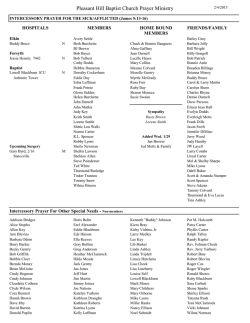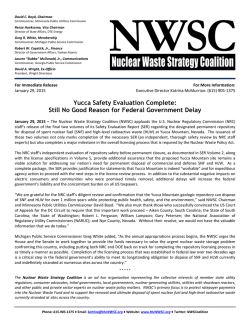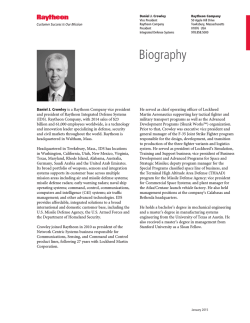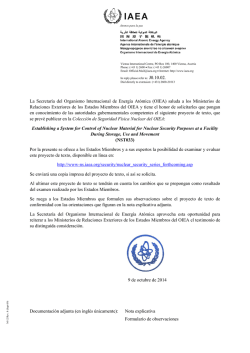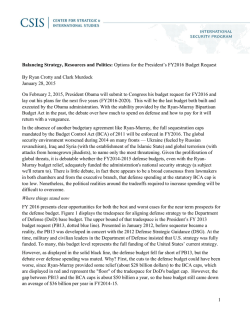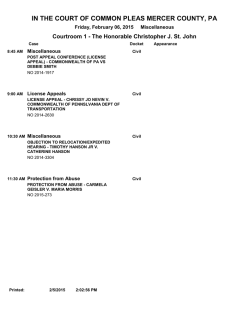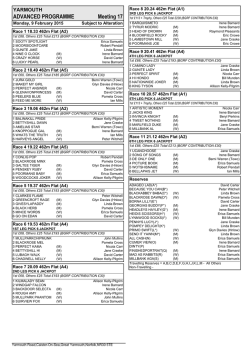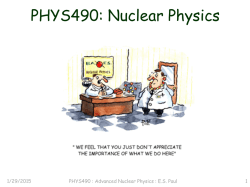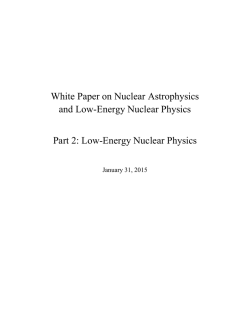
IDEAS to ACTION - Center for a New American Security
F E B R U A R Y 2 0 1 5 B R I E F I N G IDEAS to ACTION Suggestions for the 25th Secretary of Defense By: Shawn Brimley, Phillip Carter, Elbridge Colby, Patrick Cronin, Michèle Flournoy, Ilan Goldenberg, Jerry Hendrix, Nicolas Heras, Van Jackson, Katherine Kidder, Paul Scharre, Julianne Smith, Jacob Stokes, and Alexander Sullivan B O O K F E B R U A R Y 2 0 1 5 Ideas to Action: Suggestions for the 25th Secretary of Defense TA B L E O F C O N T E N T S I. Foreword3 2 | II. Invest in Key Pillars of the Offset Strategy 4 III. Defense Reform Agenda 7 IV. Middle East: Balancing Between ISIS and Iran 10 V. Asia: Ensure the Rebalance Becomes Real 13 VI. Europe: Challenges From All Directions 16 VII. Focus on America’s Nuclear Arsenal 19 FOREWORD By Shawn Brimley Dr. Ashton Carter is one of the most qualified people ever nominated as secretary of defense. He has served at every level of senior civilian leadership in the Pentagon, as assistant secretary, undersecretary and deputy secretary. He is the quintessential national security scholar and practitioner, and the nation will be better for his service during a critical period. Carter’s deep knowledge and background will be put to the test quickly, due to the complex security environment facing the United States and ongoing operations in Afghanistan, Iraq, and elsewhere. Adding to the challenge will be his presumably short tenure as the Obama administration wraps up its final two years. While he will surely testify and help shore up support for the fiscal year (FY) 2016 Department of Defense (DOD) budget submission, he did not play a critical role in its development. As secretary of defense, he will only have one major bite at the budgetary apple — the program-budget review leading up to the FY 2017 budget submission this time next year. Although he and Deputy Secretary Robert Work will develop the FY 2018 budget, it will be submitted to Congress in February 2017 and thus will be subject to review by the next commander in chief and his or her incoming leadership team. There is therefore no time to waste. Carter will need to transition into the Pentagon, develop a practical division of labor with a very capable deputy secretary, establish a modus vivendi with the White House, oversee ongoing operations, build productive relationships with Republican congressional leaders, impress his counterparts abroad, inspire the Pentagon and the men and women in uniform, signal to the service chiefs his procurement and modernization priorities and drive enough hard choices to ensure that his influence is felt long after he departs. All the while, he will need to advise President Barack Obama and his team during all the major national security challenges that will unfold over the next two years, while undertaking a grueling travel schedule to shore up critical defense relationships around the world. It is a formidable and daunting task. To help Carter and his team think through both the challenges and the opportunities the Pentagon faces, I asked several colleagues at the Center for a New American Security to not only frame some key issues, but provide specific recommendations that could serve to advance U.S. interests, drive key decisions across the defense enterprise and help Carter make a contribution that long outlasts his tenure as the 25th U.S. secretary of defense. | 3 F E B R U A R Y 2 0 1 5 Ideas to Action: Suggestions for the 25th Secretary of Defense The Navy experimental unmanned aircraft, the X-47B, taxis to it’s launch position on the flight deck aboard the nuclear powered aircraft carrier USS Theodore Roosevelt, off the Virginia coast, Sunday, Nov. 10, 2013. The Navy says the tests have demonstrated a drone’s ability to integrate with the environment of an aircraft carrier. (STEVE HELBER/Associated Press) INVEST IN KEY PILLARS OF THE OFFSET STRATEGY By Shawn Brimley, Jerry Hendrix and Paul Scharre 4 | I N V E S T I N K E Y P I L L A R S O F T H E O F F S E T S T R AT E G Y Upon his confirmation by the Senate as secretary of defense, Carter will need to articulate his vision of how he intends to lead the Pentagon over the next two years. He would do well to communicate his strategic vision quickly and tie that vision to particular choices. There are two compelling reasons why Carter will need to move quickly. First, unless Congress changes the Budget Control Act, sequestrationlevel cuts will be implemented in 2016, requiring the Pentagon to pursue another round of deep spending cuts. Working with congressional leaders to help reduce or eliminate the cloud of budget uncertainty over the Pentagon should be a priority. The second reason why Carter must move quickly is the need to slow the erosion of America’s military-technological edge. The United States has enjoyed several decades of technical dominance, but not by accident. In the 1950s, military leaders invested in nuclear power, nuclear weapons and missiles to offset the quantitative advantages the Soviet Union had in Europe. As that advantage began to erode as the Soviet Union reached nuclear parity, in the 1970s and 1980s, DOD invested in the microprocessing revolution that was then in its infancy. The result was a set of technologies – stealth, guided weapons and the global positioning system, among others – that gave the United States a renewed qualitative edge, this time powered by information technology. America’s technological edge is therefore not a given, but rather is the product of a steady series of calculated investments in key technology areas throughout the latter half of the 20th century. But as Deputy Secretary Work outlined in a speech last year: “While the United States fought two lengthy wars, the rest of the world did not sit idly by, they saw what our advantages were back in 1991’s Desert Storm, they studied them, and they set about devising ways to compete. Today, many of those earlier innovations that were spurred by the intense military-technical competition with the Soviet Union … have proliferated widely. Unsophisticated militaries and non-state actors are seeking and acquiring destructive technologies and weapons that were once the province of advanced militaries – and the price of acquiring these weapons is dropping.”1 We are approaching an era in which guided munitions, stealth and the other pillars of the last offset strategy are widely proliferated. We are approaching an era in which guided munitions, stealth and the other pillars of the last offset strategy are widely proliferated, with a much broader range of players now fully invested in the same game-changing technologies that gave the United States a dominant military-technical edge for a quarter-century. U.S. defense planners must assume that future adversaries will employ sophisticated battle networks and advanced guided munitions to both deter and defeat U.S. military forces. Carter must direct the Pentagon to revitalize its procurement and modernization efforts in order to enable U.S. forces to deter and defeat adversaries who employ guided weapons of their own, even | 5 F E B R U A R Y 2 0 1 5 Ideas to Action: Suggestions for the 25th Secretary of Defense approaching a degree of parity with the United States in some scenarios. At the same time, Carter must drive the Pentagon to accurately assess the technology landscape, much of which is now driven by a commercial revolution in information technology, to continue to invest in emerging areas to renew U.S. advantages. Fortunately, Work is already pursuing just such an effort, which he has termed a “third offset strategy,” following the first two technology strategies to offset the Soviet Union through nuclear weapons and, later, precision strike. Carter will surely embrace this effort, given his background and his close association with former Secretary of Defense William Perry, who is credited with leading the second offset strategy in the late 1970s. Quickly endorsing the ongoing effort during his nomination hearing and supporting Work and others leading the effort would increase the chances of success. Although two years is not sufficient time for such a strategy to succeed completely, Carter could increase the odds of success by focusing his attention on key defense programs that constitute the “weight-bearing” pillars of the new offset strategy. Specifically, Carter should ensure that the Pentagon prioritizes: 1.A penetrating long-range bomber. The United States needs a successor to the B-2 bomber, a new long-range strike aircraft that can operate from long ranges, carry nuclear or conventional guided weapons and operate in and around contested airspace. 6 | 2.Unmanned carrier-based strike aircraft. America’s aircraft carriers are increasingly at risk from long-range guided ballistic and cruise missiles that can target the carrier well beyond the range of its aircraft. In order to ensure that the aircraft carrier remains relevant across the range of plausible military contingencies, the U.S. Navy must buy back the range of its air wing. The best way to do that would be to procure a long-range penetrating unmanned aircraft that can operate and persist in contested airspace. 3.Undersea dominance. A military designed to project and sustain striking power in a world of guided munitions will require greater investment undersea, where forces can get close to an enemy’s shores undetected. From replacing the Ohio class of ballistic missile submarines to investing in unmanned underwater vehicles (UUVs) and semisubmersibles, the United States should move assertively to not only sustain its historic advantage undersea, but leverage the undersea environment to project power. 4.Emerging technologies. A number of new capabilities are well along in their development; hypersonics, electromagnetics, directed energy and various aspects of cyber have “gamechanging” potential that have not been fully anticipated by plausible U.S. competitors. Carter should work quickly to ensure a strategy-driven approach to research and development spending by DOD and a detailed demand signal communicated to the broader defense industry, which desires greater clarity from Pentagon leaders. Carter, once confirmed by the Senate, will report to the Pentagon as one of the best-prepared secretaries of defense since the position was created, but his success will be measured by what he can accomplish in the short time allotted to him. He needs to focus on a few key decisions and investments. The long-range bomber, unmanned combat aircraft, a new generation of manned and unmanned submarines, and a strategy-driven approach to investing in emerging technologies should be at the top of his list. 1. Robert O. Work, “Deputy Secretary of Defense Speech” (National Defense University, Washington, August 5, 2014), http://www.defense.gov/Speeches/ Speech.aspx?SpeechID=1873. Army Gen. Martin E. Dempsey, chairman of the Joint Chiefs of Staff, together with Defense Secretary Chuck Hagel, and Defense Department Comptroller Robert Hale testify before the Senate Appropriations Committee’s defense subcommittee about the Defense Department’s fiscal year 2015 budget request in Washington, D.C., June 18, 2014. Glenn Fawcett/DOD) DEFENSE REFORM AGENDA By Michèle Flournoy, Katherine Kidder and Phillip Carter | 7 F E B R U A R Y 2 0 1 5 Ideas to Action: Suggestions for the 25th Secretary of Defense DEFENSE REFORM AGENDA While there is no shortage of national security challenges confronting the United States abroad, mounting challenges within DOD loom as potentially the toughest battles ahead for Carter: exponential and unsustainable increases in personnel costs, system inefficiencies and deteriorating purchasing power. Declining defense budgets and the post-conflict drawdown will further exacerbate the impact of inefficiencies on military capabilities and readiness. The new secretary of defense must address these internal threats in order to maintain the combat power necessary to safeguard U.S. national security, now and in the future. To do so, he must fundamentally transform the way DOD does business. There are a number of key issues that the new secretary should take on, including: Military Compensation Reform 8 | Carter’s confirmation hearings will occur in the immediate wake of the review by the Military Compensation and Retirement Modernization Commission, released on January 29. After an internal DOD review, he will have to submit the Pentagon’s official response regarding proposed changes to military pay, benefits and retirement by March 13. Although the recommendations will likely be controversial, Carter should use the opportunity to articulate a comprehensive compensation reform agenda for the department that not only saves money and ensures fairness but also recasts the debate as one about sustaining and strengthening the all-volunteer force (AVF). Rather than debating whether this or that co-pay should increase, the department response should focus on ways to provide service members, retirees and their families with better health care at lower cost by leveraging best practices from the private sector and overhauling DOD’s antiquated health care system. Similarly, the department has an opportunity to recast compensation debates in terms of talent management and the best practices necessary to recruit and retain the talent necessary to meet the military’s current and future needs. Delayering The next secretary of defense must address unnecessary overhead in the Pentagon, defense agencies and headquarters staffs by removing unnecessary management layers and right-sizing organizations that have grown substantially over 14 years of war. In order to reshape the DOD civilian workforce, he must work with Congress to obtain the requisite authorities, such as reduction in force (RIF) authority and meaningful voluntary separation incentive pays (VSIP), to reshape and right-size the civilian workforce in DOD. Congress gave these authorities to the last secretary of defense who had to manage a major drawdown (William Perry), and it should provide these tools to Carter as well. Better Balancing of the Total Force The next secretary of defense will inherit a highperforming active, reserve and Guard force with nearly 14 years of combat experience. He should seek to optimize the relationship between these components, striking the right balance between active and reserve forces to maintain both capacity and capability – and also leverage the unique strengths of each component. This will be no small challenge given the fierce competition for dwindling resources and the historical friction between these elements. But the active and reserve components cannot reach an accommodation without the secretary providing a compelling vision for the total force and the political top cover to get the necessary political buy-in from key stakeholders within the department, on Capitol Hill and in the states because of the National Guard’s involvement. Cost savings should not be the only driver in these decisions; the capability and readiness requirements associated with future contingencies, along with normative factors such as the role of the Guard and reserves in civil-military relations, should be weighed heavily too. Base Realignment and Closure (BRAC) A perennial battle between DOD and Congress, the closing of underutilized bases could yield significant savings. DOD predicts nearly $2 billion in savings would be available if just 5 percent of excess infrastructure is divested. Currently, the department estimates that it has 20 percent more infrastructure than it needs. Carter will need to make a compelling case to Congress in order to find agreement on BRAC. Such a case must combine the intense fiscal pressure on the services plus the immense savings available through BRAC, based on the track record of previous BRACs in saving the department billions. The choice must be presented to Congress in fairly stark terms: Given finite resources, the nation can keep aging military bases or invest in a military ready for current and future contingencies, but it probably cannot afford both. Acquisition Reform Though it has eluded DOD for some time, Carter is uniquely positioned to address meaningful acquisition reform, given his background as the former undersecretary of defense for acquisition, technology and logistics and the father of the “Better Buying Power” series of reform initiatives. When confirmed, he will have the opportunity to implement his vision for sustaining a technologically superior American military. To seal his legacy, he will have to halt the endless “requirements creep” that disrupts production timelines and increases costs exponentially. He should also redesign incentives for program managers, putting a premium on delivering weapons systems on time and under budget. He should support a comprehensive talent management strategy for a professionalized acquisition corps, strengthening core acquisition competencies and enabling closer relationships with industry partners. Ultimately, Carter’s leadership will be necessary to ensure that the American taxpayer dollars are spent more wisely and procurement timelines are more responsive to need. Auditability DOD has yet to meet the 1994 Government Management and Reform Act mandate for full auditability. DOD must establish full accountability for everything within its purview – financial, material and personnel. Not only will a clean audit produce transparency at the institutional level, but the process involved in producing one will foster an environment where the relationship between accountability and readiness is clearly understood. Doing the Small Things Well In the projected fiscal environment, any inefficiency in the way DOD sources basic items exacts a trade-off in readiness and capability. Carter will have to ensure that DOD is drawing best practices from the business community, such as reverse auctioning for commercial off-the-shelf products and strategic sourcing. As Carter seeks to drive reform inside the Pentagon, he will also have to cultivate healthy working relationships across Washington. Many of the necessary reforms will require significant buy-in from members of Congress, a set of relationships he will have to tend closely. This may be difficult in the last two years of an administration that faces a Congress controlled by the opposite political party, but it is essential to implementing a defense reform agenda that enables the department to be ready for future threats. | 9 F E B R U A R Y 2 0 1 5 Ideas to Action: Suggestions for the 25th Secretary of Defense ISIS fighters celebrate the shooting down of an aircraft and capturing its pilot in Tal Abyad, Raqqa, Syria. (Walayat Raqqa Twitter/ISIS media) MIDDLE EAST: BALANCING BETWEEN ISIS AND IRAN By Ilan Goldenberg and Nicholas A. Heras 10 | MIDDLE EAST: BALANCING BET WEEN ISIS AND IRAN Once confirmed, Carter’s focus on the Middle East will be mostly spent on two challenges. First, he will have to provide strategic advice to the president about military operations against the so-called Islamic State of Iraq and Syria (ISIS). This will likely consume more of Carter’s time than any other matter he is facing around the globe, given that U.S. military forces are in the midst of an active conflict. Carter’s second challenge will be to manage the consequences of the nuclear negotiations with Iran, which will require active Pentagon involvement to reassure regional partners and deter Iranian actions counter to American interests. If things go bad, Carter may need to provide the president with options to pressure Iran to return to the negotiations, or in the worst-case scenario, to consider military responses to an Iranian nuclear breakout. ISIS: The Immediate Challenge The U.S.-led campaign against ISIS is likely to continue for years. The secretary of defense, working closely with the president, will need to start by clearly articulating the overall strategic objective of this effort – specifically, whether the campaign is to eliminate ISIS or simply to contain and slowly roll it back, while ensuring it does not destabilize the region. Carter will also have to evaluate whether any military strategy can work in Iraq and Syria given the underlying political dynamics and sectarian tensions, as well as whether an approach that simply contains ISIS to portions of Iraq and Syria is sufficient – or if the risk is that such a strategy would create long-term bases of operation for international jihadist fighters seeking to undermine the security of U.S. allies and strike at the West. The Obama administration’s rhetoric calls for the elimination of ISIS, but the resources being devoted to the challenge clearly indicate that the president is wary of getting drawn in to another Middle East quagmire. Whichever strategy is chosen will likely necessitate the active, long-term assistance of U.S. forces, even if the objective is more limited and much of the fighting will be borne by regional partners. In addition to the overall objective and associated resources, Carter will also have to continuously evaluate whether the overall military strategy is working. In Iraq, the focus should be on degrading ISIS’ offensive capabilities with airstrikes and enabling Iraqi security forces and Kurdish peshmerga to eject ISIS from Iraq. Carter will likely need to help decide whether additional ground forces and special operations forces are necessary for the strategy to work, or whether the current approach is working sufficiently. The greater challenge will be in Syria, where the current U.S. strategy calls for training a new force of secular nationalist rebels who will oppose ISIS. It is an open question whether such an approach is at all feasible, and Carter will need to continuously evaluate options and make recommendations to the president about whether this approach can work. ISIS has a near monopoly of violence in the areas of Syria that it controls. Secular nationalist Syrian rebel groups are weak compared with antiISIS, militant Salafist groups in these areas of the country. U.S. military training of Syrian rebels on the territory of regional allies will be complicated by the insistence of these allies that the rebels be encouraged to fight the Asad regime as well as ISIS. Iran: The Longer Game When it comes to Iran, U.S. military strategy will be largely determined by what happens over the next few months. In the event of a comprehensive negotiated agreement on the nuclear program | 11 F E B R U A R Y 2 0 1 5 Ideas to Action: Suggestions for the 25th Secretary of Defense between the P5+1 (United States, Russia, China, France, Great Britain, Germany) and Iran, DOD’s role will be to reassure the Gulf Cooperation Council states and Israel that a nuclear agreement does not mean abandoning the region to Tehran. Failure to provide such reassurance would lead America’s partners to take their own course and escalate the regional competition with Iran in Lebanon, Syria, Iraq and Yemen, causing greater instability and possibly threatening the nuclear agreement itself. In the event of a collapse in the negotiations, the U.S. military will continue to play the role it is already playing – deterring troublesome Iranian behavior, reassuring U.S. partners and being prepared to respond in the event of a contingency. However, under this scenario the president might also ask Carter for additional options to increase military pressure, through more aggressive exercises or active messaging of U.S. presence, as part of a broader effort that would certainly involve new economic sanctions in an attempt to coerce the regime in Tehran to come back to the negotiating table. Two factors will drive U.S. defense policy in the Middle East over the next two years and likely beyond that: (1) the U.S. response to ISIS; and (2) the outcome of the nuclear negotiations with Iran. 12 | In the worst-case scenario, where a collapse in the talks leads to an Iranian decision to break out and attempt to obtain a nuclear weapon, the president might also ask Carter to have available military options to destroy or degrade Iran’s nuclear program should he choose to pursue that course of action. Two factors will drive U.S. defense policy in the Middle East over the next two years and likely beyond that: (1) the U.S. response to ISIS; and (2) the outcome of the nuclear negotiations with Iran. The common challenge for Carter and his team across both of these issues will be how to reassure the United States’ partners while making clear to adversaries in the region that the United States remains committed to the Middle East, while not overcommitting in a region where perpetual crises often lead to heavy investments in time and resources that are not necessarily proportional to the interests at stake. Forty-two ships and submarines representing 15 international partner nations steam in close formation during exercise Rim of the Pacific (RIMPAC) 2014. (U.S. Navy) ASIA: ENSURE THE REBALANCE BECOMES REAL By Patrick Cronin, Van Jackson and Alexander Sullivan | 13 F E B R U A R Y 2 0 1 5 Ideas to Action: Suggestions for the 25th Secretary of Defense ASIA: ENSURE THE REBALANCE BECOMES REAL The next secretary of defense needs to make the United States’ “rebalance to the Asia-Pacific” an indisputable fact. Even in the face of global challenges and constrained resources, it is essential to strengthen America’s influence to preserve peace and adapt a prosperous, rule-based regional order. Locking in deterrence and readiness for sudden change on the Korean Peninsula remains the first order of the day. Leveraging the capabilities of allies and partners can help offset constraints on U.S. armed forces, even as the United States continues to move more of its most advanced platforms to the region. Lowering points of friction with China should be a focus of effort and can be achieved in part through effective engagement and greater transparency. Locking in Deterrence and Readiness No actor is more capable of creating a regional conflict than North Korea. Pyongyang’s recent attack on Sony has attracted attention for its novelty, but the country’s nuclear and missile threat is a more lethal danger that continues to grow unconstrained. Although the size and shape of North Korea’s nuclear arsenal is unclear, research, development and testing of delivery vehicles suggest it is moving in the direction of eventually establishing a survivable nuclear capability, which poses a strategic problem insofar as a secure deterrent convinces North Korea it can launch provocations or even limited military campaigns without risk of nuclear war. Nothing in U.S. policy today suggests that North Korea’s nuclear progress will be halted or rolled back. 14 | The secretary of defense is uniquely responsible for military contingency plans, and Carter will therefore need to ensure that DOD is preparing for the possibility of limited military campaigns on the Korean Peninsula. The United States and ally South Korea have long prepared for total war with North Korea, and in recent years the prospect of North Korean collapse as well. Limited-war scenarios, however, fall in between these two extremes and demand a distinct set of objectives, resources and planning assumptions, beyond simply planning to parry a single provocation. A diplomatic solution to the North Korean nuclear program might still be possible, but if that ultimately fails, the alliance must be prepared for the political-military realities that follow. Leveraging Ally and Partner Militaries Asian governments are redoubling efforts to modernize their militaries at a pace that exceeds any point since the end of the Cold War. As states build up their military capacities, there is a risk of arms racing in some weapons categories, posing potential interoperability challenges between the United States and its allies and partners, and the possibility of inadvertent escalation due either to misunderstandings or a deliberate attempt by aggressors to exploit the ambiguities that often accompany new technologies. To harness the military modernization trend in a positive direction of assured access, Carter should pursue a security cooperation strategy that prioritizes building ally and partner local capacity to counter the power projection forces of plausible adversaries. From traditional allies such as Australia, Japan and the Philippines to burgeoning partners such as Indonesia, India, Vietnam and Malaysia, the United States can help steer the region toward a defensive rather than offensive orientation by facilitating ally and partner investment in sea-based mines, submarines, littoral combat ships, land-based anti-ship missiles and maritime surveillance equipment. After more than half a century of relative passivity in regional security affairs, Japan is poised to play a greater role in the region, even as historical tensions linger in the background with some during this 70th anniversary of the end of World War II. The next two years will see Japan’s first forays into limited exercise of collective self-defense, which will require further negotiations, implementation and exercising. Carter will need to continue working closely with Japan as it carves a constructive and cooperative security role for itself in the region. Given the intimacy of the alliance, the United States can be a leading voice in pre-emptively allaying any concerns that Japan’s neighbors might have by not only explaining the benefits of Japanese security contributions, but by making those contributions part and parcel of the alliance relationship. The United States should also help broker intra-Asian security cooperation, including Japanese engagement with other allies and partners throughout the region. Lowering Friction Points with China Even as the United States pursues the benefits of cooperation with China on a range of issues, uncertainty remains about China’s long-term intentions and its recent assertiveness in contested maritime territories The United States should welcome and accommodate a rising China, but not necessarily its more assertive behavior. Imposing costs on coercion can best be accomplished not only by a demonstrable presence and a stronger network of durable partners, but also by expanding regional transparency. Incomplete domain awareness across vast stretches of sea and sky makes it easy for aggressors in high-friction areas to coerce while obscuring the line that separates aggressor and defender. Two policy tasks relating to China can help remove potential flashpoints. First, continue institutionalizing operational-level military-tomilitary engagement so interaction becomes an unbreakable habit. Military engagement that develops and strengthens rules for preserving operations at sea and in the air — such as the two Incomplete domain awareness across vast stretches of sea and sky makes it easy for aggressors in high-friction areas to coerce while obscuring the line that separates aggressor and defender. confidence-building mechanisms agreed to by Obama and his Chinese counterpart, Xi Jinping, last November — should not be subordinated to larger swings in the relationship. Habituated interaction can help insulate lower-level cooperation from political caprice. Second, Carter can help inject transparency into contested maritime areas by constructing a requirements road map for a regional common operating picture among participants. The surveillance and information-sharing activity necessary to achieve this level of transparency can dampen opportunistic coercion and foster limited cooperation. It can facilitate Chinese cooperation and raise the barrier to coercion and tension. The idea of locking in deterrence, leveraging allies and partners and lowering friction points with China should be elaborated in the maritime security and regional strategy documents required by Congress. Carter faces a complex and fast-moving Asia-Pacific region. The next two years provide a critical opportunity to not simply manage shortterm crises, but shape longer-term conditions in favor of enduring peace and stability. | 15 F E B R U A R Y 2 0 1 5 Ideas to Action: Suggestions for the 25th Secretary of Defense Ukraine army cuts off main road to Sloviansk. (Sasha Maksymenko, FLICKR) EUROPE: CHALLENGES FROM ALL DIRECTIONS By Julianne Smith and Jacob Stokes 16 | EUROPE: CHALLENGES FROM ALL DIRECTIONS While conflicts and brewing tensions in the Middle East and Asia will occupy a large part of his time once he is confirmed, Carter will also find himself heavily engaged in transatlantic security issues as Europe faces challenges from all directions. First among these concerns is Russia, with its annexation of Crimea, ongoing military operations in Ukraine and acts of intimidation throughout its neighborhood. Looking south, the breakdown of order in the Middle East and North Africa threatens stability in Southern Europe through refugee flows, foreign fighters and civil wars close to Europe’s borders. And to the West, Europe and the NATO alliance itself face an array of internal challenges as they work to reverse shrinking military capabilities, spur institutional innovation and build consensus around a common sense of future purpose. For Carter, meeting those challenges will require steady engagement with European interlocutors, his support of strong U.S. leadership and trans-Atlantic resolve driven in large part by an unwavering commitment of the U.S. military to European security. Given all of the other national security challenges around the globe at the moment, the temptation might be to leave European security to the Europeans. Without U.S. engagement, though, Europe might fail to meet the challenge, leaving both its citizens and its allies more at risk. Most immediately, Carter will need to find ways to boost deterrence against Russia and enhance transatlantic reassurance efforts in Central and Eastern Europe, most prominently in Poland and the Baltic states. Ensuring that Russian forces cannot undertake a successful hybrid warfare campaign on NATO territory as they did in Ukraine is the most important task for European security today. Such a campaign would be a devastating blow to the Article 5 foundation of NATO, threatening the viability of the alliance itself. Because Europe remains divided on the degree to which the West should reassure NATO allies and whether additional punitive measures against Russia are necessary, the United States will need to help bridge those divides and prevent European internal debates from creating policy paralysis. Ensuring that Russian forces cannot undertake a successful hybrid warfare campaign on NATO territory as they did in Ukraine is the most important task for European security today. Helping the Ukrainian military build capacity to wage the ongoing campaigns in the Donbass region and protect itself against future attacks should also be a high priority. Like Europe, Washington remains divided on the value of providing lethal assistance to the Ukrainians. Given that Russia has made no effort to implement or even pretend to implement the so-called Minsk Protocol, taking a hard look at Ukrainian military requirements (at least from a defensive perspective) and how the United States and its European allies can meet those requirements together makes sense. At the same time, Carter should avoid a situation where every aspect of military cooperation and engagement with Russia is put on hold. He should task his staff with identifying low-level | 17 F E B R U A R Y 2 0 1 5 Ideas to Action: Suggestions for the 25th Secretary of Defense opportunities to maintain practical cooperation with Russia since past experience has shown the risks both countries assume when all channels of engagement are turned off. Russia’s recent decision to suspend cooperative efforts to lock down or destroy nuclear material threatens security globally, including in Russia itself. The United States and Western allies need ways to engage the Russians on this and many other pressing security matters, including its continued cooperation in the multilateral negotiation process on Iran’s nuclear program. In addition to the urgent situation in Ukraine, Carter must address the slow-motion crisis in European defense spending. The recent Wales Summit included pledges to stop the bleeding, but without constant U.S. pressure and engagement on this issue, it is unlikely those pledges will be realized. The United Kingdom has just started another Strategic Defence and Security Review, and debates about meeting NATO’s stated defense spending target of 2 percent of gross domestic product (GDP) are already unfolding. This issue is a tired one, but nevertheless it remains the sine qua non of European security and the viability of NATO over time. Allies must spend more and spend smarter. There is no way around it. In the medium term, Carter must tackle four broader issues relating to NATO and European security. First, the alliance needs to do some soulsearching about the first principles behind “out of area” operations. That conversation should look back at Afghanistan and Libya but should focus more on how European members of NATO can contribute to building security and stability in the Middle East and North Africa. Some European countries remain hesitant to examine lessons learned, but the United States should push for such an effort to be launched. Second, Carter must weigh tough trade-offs concerning nuclear and missile defense forces. 18 | The next few years will be crucial across the U.S. nuclear and strategic enterprise, and many of the decisions will have profound effects for European NATO allies and relations with Russia (see Elbridge Colby’s commentary below). Carter will have to balance political and strategic issues, such as signaling and alliance management, with technical issues relating to capabilities, costs and delivery timelines. Third, the High North will merit increasing attention, as Russia increases both its capabilities and maneuvers in the region, both around the Nordic nations and in the Arctic. Currently, U.S. and allied capability for operating there lags behind Russia’s. The region should be not be militarized – in fact, the region could serve as an area of cooperation with Russia – but ensuring the United States can operate there is essential. Fourth, Carter should search for ways to include allies and partners in DOD’s efforts to spur innovation in the defense sector, both in technologies and management. Given the crucial role allies and partners play in U.S. defense strategy, ensuring their integration in U.S. planning should be a primary focus. Carter will therefore have to spend considerable time both explaining the Pentagon’s ongoing Defense Innovation Initiative (the so-called third offset strategy) and helping allies identify ways to complement it. A B-52 Stratofortress from Minot Air Force Base, N.D., flies over the Pacific Ocean on Nov. 12. The B-52 is deployed to Andersen AFB, Guam, as part of U.S. Pacific Command’s continuous bomber presence in the region. (US Air Force) FOCUS ON AMERICA’S NUCLEAR ARSENAL By Elbridge Colby | 19 F E B R U A R Y 2 0 1 5 Ideas to Action: Suggestions for the 25th Secretary of Defense F O C U S O N A M E R I C A’S N U C L E A R A R S E N A L Carter’s confirmation hearing offers an excellent opportunity to cast a brighter light on the importance of the nation’s nuclear deterrent and the consequent need to take decisive action to ensure its continued effectiveness in a new strategic and military-technological era. Carter’s nomination is especially auspicious because he is a well-known advocate for nuclear forces, based both on his long list of academic publications and, more importantly, on his consistent record during his previous tenures in the Pentagon of support for often unromantic but crucial elements of the nation’s strategic posture. Focusing on DOD’s responsibilities for the U.S. nuclear arsenal is especially important now because the country is about to embark on a decades-long recapitalization of its nuclear forces and supporting infrastructure. This is not just good sense – it is vital. The world is becoming considerably more competitive and indeed dangerous, and military force and particularly nuclear weapons are becoming more salient in key regions such as Europe and East Asia. Yet the U.S. nuclear arsenal and the architecture that supports it, which mostly date from the Reagan administration and before, are becoming outdated and in some cases bordering on the decrepit, even as blue-ribbon reports testify to profound organizational and morale problems among those who operate elements of the force. This is unsurprising. After the Cold War, the United States canceled its nuclear modernization plans and for most of the ensuing two decades confined its efforts in the nuclear weapons area almost exclusively to sustainment and rounding out old orders – when it was not canceling systems or downgrading organizations responsible for nuclear weapons. This meant deferring to a later 20 | date payment for maintaining a top-shelf nuclear deterrent. The bill is now coming due in more ways than one. First, the bill is literally coming due in the sense that over the coming decades the United States rightly plans to build a new ballistic missile submarine, extend the life of and eventually replace its land-based ballistic missile, make its new bomber capable of delivering nuclear weapons, upgrade its graying command and control architecture for its strategic forces and bring the task of operating the cornerstone of the nation’s security back up to the standard its work merits. These all make sense, given that the reasons the nation has a nuclear deterrent of such size and sophistication continue to exist, and in many respects are even looming larger. But, while doing all this will demand a relatively small fraction of the defense budget (probably between 4 percent and at most 7 percent – consistent with historic levels), they will require intelligent budgetary planning. This is particularly important because the cost of replacing the nation’s ballistic missile submarine – by most accounts the cornerstone of the nation’s nuclear arsenal – will form a painful peak in the defense budget over the 2020s, jeopardizing especially the Navy’s broader, also very important, shipbuilding plans. Second, the relative neglect of nuclear weapons issues over the last quarter-century has left a deficit in the preparedness of the U.S. military to confront the types of nuclear challenge the country is most likely to face in the coming years. The United States is prepared to meet the canonical threat of a major nuclear attack by, say, Russia, but it is not well-postured to meet the challenge of limited nuclear use by a Russia or China or to confront a nuclear-armed North Korea ready to use its growing arsenal to make traditional U.S. military plans for Pyongyang less than palatable. This lack of preparedness is often felt less in terms of capabilities and more in terms of the mentality and training of officers and officials up and down DOD’s chain of command, individuals brought up in a world of unquestioned U.S. military supremacy and a focus on stabilization operations and counterterrorism. To its credit, the Pentagon has recognized these problems and has begun to address them. DOD has offered an impressive plan for recapitalizing the nation’s nuclear weapons platforms and associated architecture, as well as a solid road map for revitalizing the nuclear mission within the U.S. Air Force. There is also an increasing candor about the broad challenges to U.S. military superiority and in particular about the threat posed by the role of nuclear weapons in the military strategies of potential adversaries. But these initiatives are only as good as the budgets that Congress approves for DOD and the consistency with which internal reforms are carried out. For this reason, Carter should, if confirmed, build on his previous legacy and provide the crucial advocacy and support for these modernization and reform initiatives that only a secretary of defense can impart. Nor should he confine his efforts solely to speeches touting the importance of the nation’s nuclear deterrent. Rather, he should push his subordinates in the department to ensure that funding for nuclear modernization and reform is prioritized in the Pentagon’s budget submission. And then he should use his political capital to ensure that those nuclear priorities are defended both in intra-administration budget debates and on Capitol Hill. A major part of this will be figuring out how to develop a politically tenable plan to get over the peak years of nuclear-related costs for the recapitalization effort, particularly in the 2020s. One promising idea is a national deterrent fund – basically creating a dedicated fund for the nation’s nuclear forces within the defense budget that would be distinct from the services’ other expenditures. At the same time, Carter should push to ensure that nuclear issues are integrated more effectively into the development of DOD’s war plans, military doctrine and strategies. This should not be designed to increase the chances of U.S. nuclear use but rather, by preparing for how to respond to adversaries’ potential employment, to minimize them. This means doing more than just nodding in the direction of the problem, as the last Quadrennial Defense Review in some respects did. Rather, it means urging – and if necessary pressuring – the appropriate commands, services and agencies to think through how to deal with the challenges posed by potential adversary nuclear escalation. One facet of this problem requiring particular attention is ensuring that nuclear weapons considerations are integrated more effectively in the regional combatant commands. In addition, Carter should demonstrate through the unique powers of the secretary – many of them informal – the importance he and the nation accord to its nuclear forces. Part of this is ensuring that DOD actually implements the commendable proposed responses to this fall’s Nuclear Enterprise Review – steps such as improving the work environment for the nation’s missileers. But it also means ensuring that nuclear issues and those responsible for them are included as integral parts of DOD planning and process. In essence, there is a solid way forward for the nation’s nuclear deterrent, much of which Carter himself has had a hand in shaping. While it is not perfect, it is a good plan that can be improved on in future years. The key right now, given the political constraints in which the new secretary of defense will operate, is for him to provide the focused but potent support for following through on it. | 21 About the Authors Shawn Brimley is Executive Vice President and Director of Studies at the Center for a New American Security. Phillip Carter is Senior Fellow, Counsel and Director of the Military, Veterans, and Society Program at the Center for a New American Security. Elbridge Colby is the Robert M. Gates fellow at the Center for a New American Security. Patrick Cronin is a Senior Advisor and Senior Director of the Asia-Pacific Security Program at the Center for a New American Security. Michèle A. Flournoy is Co-Founder and Chief Executive Officer of the Center for a New American Security. Ilan Goldenberg is Senior Fellow and Director of the Middle East Security Program at the Center for a New American Security. Jerry Hendrix is a Senior Fellow and the Director of the Defense Strategies and Assessments Program at the Center for a New American Security. Nicolas Heras is the Research Associate in the Middle East Security Program at the Center for a New American Security. Van Jackson is a Visiting Fellow at the Center for a New American Security and a Council on Foreign Relations International Affairs Fellow. Katherine Kidder is a Research Associate at the Center for a New American Security’s Military, Veterans, and Society Program. Paul Scharre is a Fellow and Director of the 20YY Warfare Initiative at the Center for a New American Security. Julianne Smith is Senior Fellow and Director of the Strategy and Statecraft Program at the Center for a New American Security. Jacob Stokes is the Bacevich Fellow at the Center for a New American Security. Alexander Sullivan is a Research Associate at the Center for a New American Security.
© Copyright 2025
